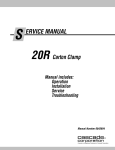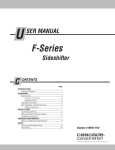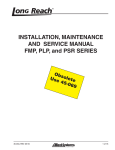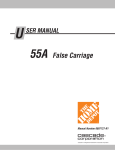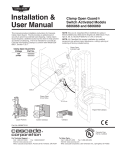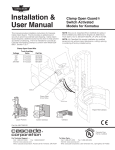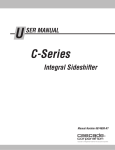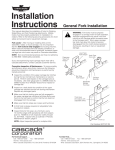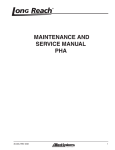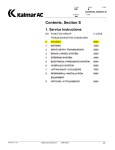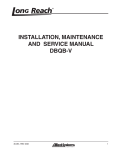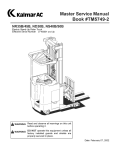Download 0 - Cascade Corporation
Transcript
l Service Manual 30D QFM’” Quick Fork Mount Push/Pull Serial Numbers 677190 through 677192 a Manual Number 678535 cascade” Cascade is a Registered Trademark of Cascade Corporation l QFM is a Trademark of Cascade Corporation * . . t‘ Contents Page Number 1 INTRODUCTION, Section 1 ................. INSTALLATION INSTRUCTIONS, Section 2 ... ,.l 1 Truck Requirements ....................... 2 Installation. .............................. 2 Prior to installation ...................... 3 Initial Installation ........................ 5 Prior to Operation ....................... 5 PERIODIC MAINTENANCE, Section 3. ........ 6 TROUBLESHOOTING, Section 4 ............. 6 General Procedures ....................... 6 Truck System Requirements ............... 6 Tools Required ......................... 6 Get All the Facts ........................ 7 Plumbing ............................... 7 Hosing Diagram ........................ 7 Circuit Schematic ....................... 8 Push/Pull Circuit .......................... 9 SERVICE, Section 5 ....................... 9 Attachment Removal and Installation .......... 10 Faceplate and Linkage. .................... 10 Disassembly and Reassembly ............. .12 Link Service .......................... .13 Hose Installation ....................... Valve...................................1 4 .14 Removal and Installation ................. .14 Disassembly and Service ................ .15 Cylinders. .............................. Gripper Cylinder Removal and Installation .... 15 Push/Pull Cylinder Removal and Installation .15 .16 Push/Pull Cylinder Adjustment ............ .17 General Cylinder Service Procedures. ...... .18 Gripper Cylinder Service ................. .18 Push/Pull Cylinder Service ............... .19 Platens ................................ .19 Removal and Installation ................. .19 Inspection ............................ .20 SPECIFICATIONS, Section 6 ............... Hydraulics...............................2 0 .20 Truck Carriage .......................... .21 Torque Values .......................... 678535 Rev. 0 1 Introduction Section This manual provides the installation instructions, periodic maintenance requirements, troubleshooting procedures and service guides for 30D QFM TMQuick Fork Mount Push/Pulls. Note that all specifications are shown in US and (Metric) units where applicable. 1.1 Special Instruction Definitions A statement preceded by A WARNING is information that should be acted upon to prevent bodily injury. A WARNING is always inside a ruled box. CAUTION A statement preceded by CAUTION is information that should be acted upon to prevent machine damage. IMPORTANT A statement preceded by IMPORTANT is information that possesses special significance. NOTE A statement preceded by NOTE is information that is handy to know and may make your job easier. 2 Installation Instructions Section 2.1 Truck Requirements 0 A A WARNING: The QFM TMPush/Pull must be mounted on standard forks to support the load and the attachment. 0 Sideshifter Limitations: To avoid mounting interference, the Sideshifter components and cylinder must not protrude in front of the carriage fork bars. 0 Fork Specifications: Forks up to 1.8 in. (4.5 cm) thick and 40-46 in. (101-l 16 cm) long may be used. Recommended fork length is 42 in. (106 cm) with bottom taper. The forks must be adjustable to 22.5-25.5 in. (57-64 cm) between the inner edges of the forks. l Truck carriage or Sideshifter carriage must conform to ISO dimensional standard 2328, equivalent to Industrial Truck Association (ITA) dimensions shown at right. 0 Make sure the truck carriage is clean and the notches are undamaged. l In order to conform to industry standard practice, the hoses should be connected to the truck auxiliary valve as indicated in the chart at right. l Truck Relief Valve Setting: 2300 psi (160 bar), maximum. l Hydraulic flow: 4-10 GPM (15 L/min 38 L/min). l Recommended hose and fitting size: No. 6 with minimum fitting orifices of 3/8 in. (9.5 mm). -f R A WARNING: Rated capacity of the truck / attachment combination is a responsibility of the original truck manufacturer and may be less than that shown on the attachment nameplate. Consult the truck nameplate. iii 14.94 In (379.5 mm) 15.00 in. (381 .O mm) I Function, in sequence of location to the operator Attachment movement Motion of the operator’s hand when actuating the truck auxiliary control I Sideshift when equipped) Push/Pull * 678535 Rev. 0 *Trucks equipped with a three-function auxiliary control valve and solenoid adaption require the control knob electrical button to be depressed for operation of the push/pull function. 1 Section 2 Installation Instructions 2.2 Installation A 2.24 Cascade THINLINE TM Hose Reel and mast supply group for QFM TM Push/Pull Operation. WARNING: Rated capacity of the truck/ attachment combination is a responsibility of the original truck manufacturer and may be less than that shown on the attachment nameplate. Consult the truck nameplate. Prior to Installation The following preparation should be performed prior to attachment installation. The QFM M Push/Pull requires a mast hydraulic supply group. If a Sideshifter is not installed and the truck is not equipped with mast internal hose reeving, a hose reel will be required. Refer to Form 673835 for THINLINE TMHose Reel installation Instructions. A Trucks equipped with a Sideshifter and a single-function auxiliary control valve will require conversion to two function operation by installation of Solenoid Adaption Kit 674303. Refer to Form 674306 for installation instructions. Solenoid Adaption electrical schematic shown below. To utilize the attachment’s Quick Mount features, installation of hydraulic quick disconnect couplers is required. Cascade Hydraulic Quick Disconnect Coupling Kit 671045 is recommended because of the couplers’ hydraulic efficiency. Refer to Form 671422 for installation instructions. 2 WARNING: The QFM TMPush/Pull must be mounted on standard forks to support the load and the attachment. Sideshifter Hose Reel QFM” Push/Pull Hose Reel Cascade Hydraulic quick Disconnect Coupling Kit 671045 678535 Rev. 0 l .] Section 2.2-2 2 Installation Instructions Initial installation 0 Attach a hoist rated at 2000 lbs. minimum through the frame and faceplate as shown. Remove the attachment from the shipping pallet. Pull out the lower mounting hook locking pins and turn the lower mounting hooks downward until they lock in position. Place the attachment on the floor with a 2 x 4 under the platen tips. L A 0 Adjust the truck forks to a measurement of 22.5-25.5 in. (57-64 cm) between the inner edges of the forks. Engage fork detent pins in appropriate notches. 0 Position the truck carriage in the true vertical position. Lower the forks to the ground. Center the truck carriage behind the attachment. Drive forward to fully engage the truck upper carriage bar with the attachment upper hooks. Raise the attachment 1-2 in. (2-5 cm). WARNING: The QFM TMPush/Pull must be mounted on standard forks to support the load and the attachment. R \ 0 lower mounting Hooks 2x4 Connect the attachment hoses to the truck hose terminal fittings or Quick Disconnect fittings. Route the hoses to avoid interference with the mast. . Lower hooks must be in the down position. To Hose Reel NOTE: Installation of Cascade Quick Disconnect Hydraulic Coupler Kit 671045 is recommended. - quick . Disconnect Couplings 676535 Rev. 0 II 2 Installation Instructions Section 2.2-2 Initial Installation (cont.) 0 Disconnect the truck supply hoses from the attachment push/pull valve fittings. Connect the hoses together with a union fitting. Start the truck and actuate the truck control valve in both directions for about 30 seconds to carry any debris in the supply group to the truck tank and filter. On trucks equipped with solenoid adaption, the control knob electrical button must be pressed. Reinstall the hoses to the attachment. 0 Actuate the push/pull control valve to position the faceplate out approximately 3/4 of its travel on the platen. Raise the attachment to eye level to gain access to the lower mounting hooks. A WARNING: The lower mounting hooks are not secured at this time. Use caution while working near the raised attachment. ’ Lower Mounting Hooks 0 Loosen the mounting hook capscrews. Position hooks down to end of adjustment slot. Pull out the lower mounting hook locking pins. Rotate the hooks up and lock in place. Adjust the hooks for 1/16 In. (1.5 mm) clearance with the lower carriage bar. Tighten the cap screws to a torque of 55-65 ft-lbs. (74-84 N-m). Make sure the hooks swing down and lock properly for attachment removal. A 0 WARNING: The lower hooks must be firmly locked in the up position. The inside spacing between the platens can be adjusted to 4 in. or 10 in. (10 or 25 cm) as required. Remove the platen capscrews and nuts. Move the platens to line up with the other set of predrilled holes. Install the capscrews and nuts. Tighten to a torque of ft-lbs. (47-60 N-m). 35-45 Adjustable to 4 or 10 in. (10 or 25 cm). 4 678535 Rev. 0 2 Installation Instructions Section Priorto operation 2.3-3 0 Operate the attachment through several complete cycles to make sure all functions operate correctly. l Retract the faceplate and note that the gripper bar closes fully before the faceplate retracts. 0 Extend the faceplate and note that the gripper bar opens before the faceplate extends. 0 With the faceplate extended and the control valve in neutral, the gripper bar should not drift down. 0 Check for external leaks at the hoses and fittings. 3 Periodic Maintenance Section 3.1 1OO-HourMaintenance Every time the lift truck is serviced or every 100 hours of truck operation, whichever comes first, complete the following maintenance procedures. 0 Inspect the link rollers and related parts for sufficient lubrication. If necessary, lubricate with Dubois FGG-2 food industry grease, Cascade part no. 669306. 13 Inspect the hoses mounted to the links. They should be mounted securely and without hose droop. Check for hose wear and kinking. Replace kinked or worn hoses. Refer to Section 5.2-3. 3.2 IMPORTANT After completing any service procedure, always test each function through 5 complete cycles. First test the attachment empty, then test each function with a load to make sure the attachment operates correctly before returning it to the job. 500-Hour Maintenance After each 500 hours of lift truck operation, in addition to the 100-hour maintenance procedures, perform the following procedures. 0 Inspect all bushings and thrust races at the pivot points for excessive wear. Replace if. necessary. 13 Tighten the capscrews that secure the link pivot points to a torque of 20-30 ft-lbs. (27-40 N-m). q Inspect the bolts securing the gripper pad. Tighten if necessary to a torque of 15-20 ft-lbs. (20-27 N-m). 0 A WARNING: Tighten the platen capscrews to a torque of 35-45 ft-lbs. (47-60 N-m). 0 Tighten the mounting hook capscrews to a torque of 55-65 ft.-lbs. (74-87 N-m). 3.3 1000-Hour Maintenance After each 1000 hours of lift truck operation, in addition to the 100-hour and 500-hour maintenance procedures, perform the following procedure. 0 Replace all arm bushings and thrust races. 678535 Rev. 0 5 4 Troubleshooting Section 4.1 General Procedures WARNING: Before servicing any hydraulic component, relieve pressure in the system. Fully extend the faceplate, turn the truck off, and open the truck auxiliary valves several times in both directions. After completing any service procedure, always test the function through several cycles. First test the attachment empty, then test the attachment with a load to be sure it operates correctly before returning it to the job. Stay clear of the load while testing. Do not raise the load more than 3 in. (75 mm) off the floor while testing. 4.1-1 Truck System Requirements 0 The lift truck must supply sufficient hydraulic pressure to handle the heaviest load. PRESSURE MUST NOT EXCEED 2300 PSI (160 BAR). 0 Hydraulic flow: 4-10 GPM (15 L/min-38 L/min) 0 The truck hydraulic system must supply hydraulic oil to the attachment that meets the specifications shown in Section 6.1-l. 4.1-2 Tools Required In addition to a normal selection of hand tools you will need: l A pressure gauge capable of measuring pressure to 2500 psi (175 bar), Cascade part no. 671212. 0 An inline flow meter capable of measuring hydraulic flow to 20 GPM (80 L/min), Cascade part no. 671447. 4.1-3 Get All the Facts Before You Begin Working on the Attachment It is important that you gather all the facts regarding the problem before you begin service procedures. The best way is to talk with the operator. Ask for a complete description of the malfunction. The following guidelines will help you decide where to begin your troubleshooting procedures. 0 Attachment will not pull load. l Faceplate will not extend or retract. l Faceplate operates slowly. l Gripper bar will not lower or raise. l Gripper bar is not sequenced function. l Gripper bar will not hold the slip sheet when pulling load onto platens. with the push/pull If you encounter one of these problems, refer to Section 4.3. 678535 Rev. 0 Section 0 4 Troubleshooting 4.2 Plumbing 4.2-l Hosing Diagram FACEPLATE RETRACT AND GRIPPER BAR DOWN Hose Reel PRESSURE - RETURN 1 m.3:I*x.:.:<.>:...>,*,. NOTE: For faceplate EXTEND. reverse the shading shown. Truck Auxiliary Valve 4.2-2 Circuit Schematic Push/Pull Cylinders - -yr -LA Gripper Cylinders L--Gripper Bar - - Truck Hydraulic Pump 678535 Rev. 0 7 L Section 4 Troubleshooting * 4.3 Push/Pull Circuit There are five potential problems that could affect push/pull operation. l Physically jammed mechanism l Insufficient hydraulic flow and pressure l Worn or defective cylinder seals 0 Valve assembly malfunction 0 Kinked supply hoses Before proceeding, determine whether the push function or the pull function is at fault. WARNING: Before removing any hoses, relieve pressure that might be present in open the truck auxiliary control valve(s) several times in both directions. Check the pressure delivered by the truck. Refer to the truck service manual. The pressure must be within 100 psi (7 bar) of specified truck pressure. TRUCK PRESSURE SHOULD BE 2000 PSI (138 BAR) MINIMUM AND 2300 PSI (160 BAR) MAXIMUM, measured at the hose terminal. Check the flow volume at the hose terminal. See Section 6.1-l for the recommended flow volumes. Push function Gripper Bar will not raise 0 Physically jammed mechanism. 0 Kinked hoses. Gripper Bar drifts down 0 Valve assembly check valve stuck in open position due to contamination or damaged seals. Refer to Section 5.3-l. l Damaged seals in gripper cylinder. Refer to Section 5.4. Gripper Bar raises but faceplate does not extend l Valve assembly relief valve stuck in closed position due to contamination or damaged seals. Refer to Section 5.3-l. l Valve assembly cartridge valve(s) factory set relief pressures have been altered. Replace the cartridges. Refer to Section 5.3-l. Faceplate extends slowly l Worn seals in push/pull or gripper cylinders. Refer to Section 5.4. PULL FUNCTION Gripper Bar will not lower l Physically jammed gripper mechanism. l Valve assembly check valve stuck in closed position due to contamination or damaged seals. Refer to Section 5.3-l. Gripper Bar lowers but faceplate does not retract l Valve assembly check valve stuck in closed position due to contamination or damaged seals. Refer to Section 5.3-l. l Worn seals in push/pull cylinders. Refer to Section 5.4. Gripper Bar does not hold slip sheet during faceplate retract a Worn seals in gripper cylinders. Refer to Section 5.4. 0 Damaged gripper pad or jaw. 8 678535 Rev. 0 5 Service Section 0 5.1 Attachment Removal and Installation 0 Extend the faceplate to approximately 3/4 of its travel on the platen. Position the attachment 2 ft. (60 cm) off the ground with the mast in the true vertical position. 0 Pull out the lower hook locking pins. Swing the lower mounting hooks down and lock in the disengaged position. To Hose Reel 0 rli I Disconnect the quick disconnect hydraulic couplers at the truck carriage. WARNING: Before removing any hoses, relieve pressure that might be present in open the truck auxiliary control valve(s) several times in both directions. 0 Place a 2 x 4 (15 in. long) on the floor under the platen tips. Lower the attachment to the ground. Back the truck away from the attachment. 0 For installation, reverse the above procedures. A WARNING: The QFM TM Push/Pull must be mounted on standard forks to support the load and the attachment. 2x4 678535 Rev. 0 lower hooks must be in the down position. 9 5 Service Section 5.2 Faceplate and Linkage 5.2-l Disassembly and Reassembly 0 /a/ 10 Fully extend the faceplate. Attach an overhead hoist chain to the top of the faceplate. Take up slack in the chain. WARNING: Before removing any hoses, relieve pressure that might be present in the hydraulic system. With the truck off, open the truck auxiliary control valve(s) several times in both directions. 0 Disconnect the hoses from the faceplate valve. Remove the hose clamps from the faceplate and links. For reassembly, tighten the hose clamp capscrews to a torque of 4-5 ft.-lbs. (5-7 N-m). 0 Remove the capscrews from the inner secondary link lower pivot pins. Remove the pivot pins, For reassembly, tighten the capscrew to a torque of 8-10 ft-lbs. (10-13 N-m). 0 Remove the faceplate with the hoist. Tilt the faceplate to disengage the outer secondary link rollers from the faceplate channels. Set the faceplate face down. 0 Remove the capscrew from the left inner primary link at the cylinder rod end pivot point. For reassembly, tighten the capscrew to a torque of 6-7 ft.-lbs. (8-9 N-m). 0 Remove the cylinder rod end pivot pin. @ Remove the roll pins from the inner primary link lower pivot pins. Remove the pivot pins. 0 Remove the linkage assembly from the frame by lifting with an overhead hoist. Tilt the linkage assembly to disengage the outer primary link rollers from the frame channels. 0 Remove the capscrews and caps from both inner primary/secondary link upper pivot points. For reassembly, tighten the capscrews to a torque of 20-30 ft.-lbs. (27-40 N-m). @ Remove the upper pivot pin and hose guide tube. Note location of the thrust races during pivot pin removal. @ Remove the capscrews and caps from the primary link center pivot points. @ Remove the capscrews and caps from both outer primary/secondary link lower pivot points. For reassembly, tighten the capscrews to a torque of 20-30 ft.-lbs. (27-40 N-m). @ Remove the capscrews from both outer secondary link center pivot points. For reassembly, tighten the capscrews to a torque of 6-7 ft.-lbs. (8-9 N-m). @ Remove the center pivot pin and tube. Note location of the thrust races during pivot pin removal. @ For reassembly, reverse the above procedures. 678535 Rev. 0 Section a 5.2-l 5 Service Disassembly and Reassembly (cant .) Faceplate , I_ 1; Link Rollers 678535 Rev. 0 11 5 Service Section 5.2-2 Link Service Remove the links from the attachment as described in Section 5.2-l. 0 Remove the bushings from the links using a bushing driver. 0 If you do not have bushing drivers, a tool as shown at right can be fabricated for bushing removal. 0 Inspect the cam followers for excessive wear or damage. If flat spots or cracks are visible on the cam followers, they should be replaced. Cam followers with roughness or noticeable restriction to turning should be replaced. @ For reassembly, reverse the above procedures except as follows: l Bushing drivers must be used to press new bushings into the links. 0 If cam followers are being replaced, the nut should be tightened to a torque of 130-150 ft-lbs. (175-200 N-m). L.JJ,” l- 50” Ll.247” 1.240” Bushing Driver Material: AISI - 1015 (Hot Roller Mild Steel) 0 The small plug supplied with each replacement cam follower must be installed in the shaft end hole. Secondary Link .990” Use bushing drivers to remove and replace all link bushings. Cam Follower Install small plug. 12 678535 Rev. 0 Section 5.2-3 5 Service Hose Installation The attachment hoses must be installed as described below for correct hydraulic operation and tracking of the hoses with the arms during faceplate extension and retraction. Installing replacement hoses other than Cascade hose is not recommended. 0 Connect the hoses to the valve and push/pull cylinder. 0 Route hoses through the arms to the faceplate. Connect hoses to the gripper cylinder lubes as shown. 0 Install arm hose clamps to hose. Install hose clamp capscrews and tighten to a torque of 4-5 ft.-lbs. (5-7 N-m). 0 Arrange hoses as shown below. Install cable ties at the locations shown. Hose d 80.5 in. (3204 cm) View from Driver’s Seat Valve e Hose 0-1 0 Hose Hose 0, Cable Ties A3 Hose d 80.5 in. b Hose (-)204 cm 678535 Rev. 0 13 5 Service Section 5.3 Valve 5.3-l Removal and Installation 0 Fully extend the faceplate. A 5.3-2 WARNING: Before removing any hoses, relieve pressure in the hydraulic system. Turn the truck off, then open the truck auxiliary control valve(s) several times in both directions. @ Disconnect,tag and plug the hoses from the valve fittings. 0 Remove the two capscrews and nuts securing the valve. For reassembly, tighten the capscrews to a torque of 4-5 ft-lbs. (5-7 N-m). Disassembly and IMPORTANT: service Service the valve in a clean work area. 0 Remove the valve from the attachment as described in Section 5.3-l. 0 Remove fittings and plugs. 0 Remove the valve cartridges. 0 Clean all parts with kerosene or solvent. Check for contamination in pilot holes, etc. 0 For reassembly, reverse the above procedures except as follows: 0 Lubricate the check valve cartridges with STP 01 petroleum jelly prior to reassembly. 0 Tighten all fittings and cartridges to a torque of 10-15 ft.-lbs. (13-19 N-m). Back-up Ring - Cartridge Part No. 659056 Part No. 677124 LL- O-Ring ’ F )) back-up ring, O-Ring Service Kit Part No. 669597 5 Service Kit Part No. 667516 part No. 677125 678535 Rev. 0 5 Service Section t 0 5.4 Cylinders 5.4-l Gripper Cylinder Removal and Installation 0 Fully extend the faceplate. WARNING: Before removing any tubes, relieve pressure that might be present in the hydraulic system. With the truck off open the truck auxiliary control valve(s) several times in both directions. a 0 0 l 5.4-2 Disconnect the tube fittings from the cylinder fittings. Remove the cylinder anchor roll pins. Installation is a reverse of the above procedures. Push/Pull Cylinder Removal and Installation 0 Fully extend the faceplate. A WARNING: Before removing any hoses, relieve pressure that might be present in the hydraulic system. With the truck off, open the truck auxiliary control valve(s) several times in both directions. 0 Disconnect, tag and plug the hoses shown from the cylinder fittings. 0 Disconnect the tubes from the cylinder fittings. 0 Remove the lower pivot pin retaining capscrew from the L.H. inner primary link. Remove the lower pivot pin. For reassembly, tighten the retaining capscrew to a torque of 6-7 ft.-lbs. (8-9 N-m). Mark the cylinders R.H. and L.H. for reassembly. 0 Remove the upper pivot pin retaining capscrew and eyebolt. Remove the upper pivot pin. For reassembly, tighten the capscrew to a torque of 4-5 ft-lbs. (5-7 N-m). 0 After reassembly, adjust the cylinder rod length as described in Section 5.4-3. 678535 Rev. 0 15 . 5 Service Section 5.4-3 Push/Pull Cylinder Adjustment 0 Position the faceplate 1 or 2 in. short of full extension. Turn the cylinder lock nuts clockwise to the end of their travel. Turn the cylinder rods. using the wrench flats, clockwise to the end of their travel. @ Fully retract the faceplate. l The faceplate should retract smoothly without restriction or binding of the arms. 0 The push/pull cylinder should bottom internally as the faceplate makes initial contact with the frame. Adjust both cylinder rods equal amounts as required. l 0 0 II t-l If the faceplate does not retract parallel with the frame, adjust one cylinder rod as required. l- Fully extend the faceplate. The extension of the faceplate should be 5O .5 in. (127 1 cm). After all adjustments have been made, hold each cylinder rod in position and tighten the lock nuts against the rods to a torque of 100-150 ft.-lbs. (135-200 N-m). - -u - Wrench Flats Nuts 16 lIlll Rods 678535 Rev. 0 5 Service Section 0 5.4-4 General Cylinder Service Procedures Cylinder Disassembly Use a pin-type spanner wrench to remove push/pull cylinder retainers. When servicing a cylinder, clamp it in a soft-jawed vise as shown. Never clamp the cylinder shell of the cylinder rod sealing area in a vise. To remove the seal from a piston or a retainer, put the piston or retainer in a soft-jawed vise. Pry the seal up with a blunt tool such as a screwdriver, then cut the seal to remove it. Be careful not to scratch the seal Clamp cylinder in soft-jawed vise. CAUTION: Do not scratch PI Gripper Cylinder Clamp cylinder in soft-jawed vise. I I Cylinder Inspection l Inspect the rod, piston and retainer for nicks and burrs. If deeply gouged, replace the part. Minor nicks and burrs can be removed with an emery cloth. NOTE: A minor nick is one that will not cause a bypass of oil when the cylinder is operating. l Inspect the inside of the cylinder shell and remove any minor nicks and burrs with a butterfly hone. Replace the cylinder shell if it is deeply gouged. Cylinder Reassembly l Lubricate all new seals with STP before installing. l To install a new seal on a piston or retainer, hook one side of the seal in the groove and push it over the piston or retainer. NOTE: Polishing the chamfer angle will allow the seal to slide into the groove much easier. l Note the direction of U-cup seals. If they are installed backwards, the seals will not seal properly. Refer to the illustration of the cylinder you are servicing on page 18. l Reassemble the rod assembly by sliding the retainer on first, then the piston assembly. Install and tighten the piston retaining nut before sliding the rod assembly into the shell. l Observe all torque values as shown in the appropriate illustration. 678535 Rev. 0 Install new seals as shown. 17 5 Service Section 5.4-5 Gripper Cylinder Service 5.4-6 0 Remove the snap ring. 0 Remove the retainer ring by first tapping the retainer into the shell bore. Then place a screwdriver on one side of the ring and tap the screwdriver with a hammer. Do not gouge the shell bore with the screwdriver. The retainer ring should compress at the split and turn sideways as shown at right. Pull out the ring. 0 Pull the rod assembly out of the shell. 0 Remove the nut securing the piston to the rod For reassembly, tighten the nut to a torque of 40-45 ft.-lbs. (54-61 N-m). 0 Slide the piston and retainer off the rod. 0 Remove and replace all seals. @ Perform the inspection and reassembly procedures listed in Section 5.4-4. Retainer Ring 0 4!l=-= Push/Pull Cylinder Service Read the General Service Procedures, Section 5.4-4 before proceeding. ) Use a pin-type spanner wrench to remove the retainer. For reassembly, tighten the retainer to a torque of 300-350 ft-lbs. (405-475 N-m). @ Pull the rod assembly out of the shell. 0 Remove the nut securing the piston to the rod. 0 Slide the piston and retainer from the rod. 0 Remove and replace all seals. 0 Remove and replace the cylinder rod and base end bushings. l 18 If you do not have bushing drivers, a tool as shown in Section 5.2-2 can be fabricated for bushing removal. 678535 Rev. 0 5 Service Section 5.5 Platens 5.5-l Removal and Installation 0 Fully retract the faceplate. Lower the attachment to 1 ft. above the floor. 0 Remove the capscrews and nuts. For reassembly, tighten the capscrews to a torque of 35-45 ft.-lbs. (47-60 N-m). 0 Reassembly is a reverse of the above procedures except as follows: 0 The inside spacing between the platens can be adjusted to 4 in. (5.4 cm) or 10 in. (13.5 cm). Move the platens to line up with the other set of predrilled holes. Reinstall the capscrews and nuts. 5.5-2 Inspection 0 Check the platen tips for nicks. Flatten out nicks with a hammer and smooth the edges with a file or grinder. @ An application of wax or paraffin on the top of the platens will reduce friction between the platens and slip sheets. Use steel wool to remove excess wax. Spacing adjustable to 4 in. (5.4 cm) or 10 in. (13.5 cm). 678535 Rev. 0 19 6 Specifications Section 6.1-l Hydraulics I Hydraulic Specifications I 30D I Pressure-Maximum 2300 PSI (160 bar) Flow--Minimum@ ) Supply Hose & Fitting Size Minimum Orifice Size g w No. 6 318 in. (9.5 mm) Flow less than minimum will result in slow faceplate speed. Flow greater than maximum can result in excessive faceplate speed, reduced system performance and short hydraulic system life. Hydraulic Oil-Cascade attachments are compatible with SAE 10 W petroleum base oil per Mil. Spec. MIL-0-5606 or MIL-L-2104B. Use of synthetic or aqueous base hydraulic oil is not recommended. Contact Cascade if fire-resistant hydraulic oil must be used. In order to conform to industry standard practice, the hoses should be connected to the truck auxiliary valve as indicated by the chart. *Trucks equipped with a single-function auxiliary control valve and solenoid adaption require the control knob electrical button to be depressed for operation of the push/pull function. 6.1-2 Truck Carriage Truck carriage must conform to ISO dimensional standard 2328, equivalent to Industrial Truck Association (ITA) dimensions shown. Make sure the truck carriage is clean and the notches are undamaged. 14.94 in. (379.5 mm) 20 15.00 in. (381.0 mm) 678535 Rev. 0 Section 6 Specifications Torque Values Note that all specifications are shown in US and (Metric) units where applicable. Not Shown Valve fittings-l O-15 ft.-lbs. m). (13-19 N-m). Cylinder retainers and piston nuts-see Sections 5.4-5 and 5.4-6. Ref. No. Torque Values Fastener Thread Size Ft.-Lbs. (N-m 1 1/4 NC 4-5 5-7 2 1/4 NC 6-7 8-9 3 7/8 NF 130-150 (175200) 4 1/4 NC 4-5 5-7 5 3/8 NC 20-30 (27-40) 6 1/2 NC 35-45 (47-60) 7 1/2 NC 55-65 (74-87) 8 1/4 NC 6-7 (8-9) 9 1-1/4 NF 100-150 (135-200) 1 678535 Rev. 0 15-20 1 (20-27) 21 AMERICAS Cascade Corporation U.S. Headquarters 2201 NE 201st Fairview, OR 97024-9718 Tel: 800-CASCADE (227-2233) Fax: 888-329-8207 Cascade Canada Inc. 5570 Timberlea Blvd. Mississauga, Ontario Canada L4W-4M6 Tel: 905-629-7777 Fax: 905-629-7785 Cascade do Brasil Rua João Guerra, 134 Macuco, Santos - SP Brasil 11015-130 Tel: 55-13-2105-8800 Fax: 55-13-2105-8899 EUROPE-AFRICA Cascade Italia S.R.L. European Headquarters Via Dell’Artigianato 1 37030 Vago di Lavagno (VR) Italy Tel: 39-045-8989111 Fax: 39-045-8989160 Cascade (Africa) Pty. Ltd. PO Box 625, Isando 1600 60A Steel Road Sparton, Kempton Park South Africa Tel: 27-11-975-9240 Fax: 27-11-394-1147 ASIA-PACIFIC Cascade Japan Ltd. 2-23, 2-Chome, Kukuchi Nishimachi Amagasaki, Hyogo Japan, 661-0978 Tel: 81-6-6420-9771 Fax: 81-6-6420-9777 Cascade Korea 121B 9L Namdong Ind. Complex, 691-8 Gojan-Dong Namdong-Ku Inchon, Korea Tel: +82-32-821-2051 Fax: +82-32-821-2055 Cascade-Xiamen No. 668 Yangguang Rd. Xinyang Industrial Zone Haicang, Xiamen City Fujian Province P.R. China 361026 Tel: 86-592-651-2500 Fax: 86-592-651-2571 Cascade Australia Pty. Ltd. 1445 Ipswich Road Rocklea, QLD 4107 Australia Tel: 1-800-227-223 Fax: +61 7 3373-7333 Cascade New Zealand 15 Ra Ora Drive East Tamaki, Auckland New Zealand Tel: +64-9-273-9136 Fax: +64-9-273-9137 Sunstream Industries Pte. Ltd. 18 Tuas South Street 5 Singapore 637796 Tel: +65-6795-7555 Fax: +65-6863-1368 Cascade India Material Handling Private Limited No 34, Global Trade Centre 1/1 Rambaugh Colony Lal Bahadur Shastri Road, Navi Peth, Pune 411 030 (Maharashtra) India Phone: +91 020 2432 5490 Fax: +91 020 2433 0881
























